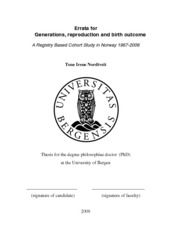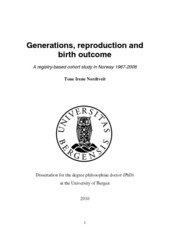| dc.contributor.author | Nordtveit, Tone Irene | en_US |
| dc.date.accessioned | 2010-02-11T11:46:41Z | |
| dc.date.available | 2010-02-11T11:46:41Z | |
| dc.date.issued | 2010-01-22 | eng |
| dc.identifier.isbn | 978-82-308-0952-5 (print version) | en_US |
| dc.identifier.uri | https://hdl.handle.net/1956/3788 | |
| dc.description.abstract | Aims: Our aim was to describe associations between birth outcomes across two generations. Hypotheses were proposed about how genetic and environmental, behavioural and socioeconomic factors may act on reproduction and birth outcomes through generations. Methods. Population-based cohort studies for two generations. Data were derived from the Medical Birth Registry of Norway (MBRN) based on all births in Norway between 1967 and 2006 (Paper I 1967-2004), more than 2.3 million births. Births were linked to the mother’s and father’s own birth records by their national identification numbers, thus providing generation files with birth records on mothers and their offspring and fathers and their offspring. Results: In Paper I, we investigated intergenerational recurrence of breech delivery and found that both men and women delivered in breech at term contribute to increased risk of breech delivery in their offspring. The highest risk of recurrence of breech delivery was observed for first-born men and women delivered at term (odds ratios (ORs) 2.2, 95% confidence interval (C.I.) 1.8 to 2.7 and 2.2, 1.9 to 2.5, for men and women, respectively). For men and women born preterm, we essentially observed no recurrence between generations. Since recurrence through the father was as strong as recurrence through the mother, it seems reasonable to attribute the observed pattern of familial predisposition to term breech delivery to genetic inheritance, predominantly through the fetus. In Paper II, we examined the associations between parents’ gestational age and birth weight and perinatal mortality in their offspring. Perinatal mortality in offspring was not significantly associated with paternal gestational age or birth weight. In contrast, we found a strong inverse association between maternal gestational age and perinatal mortality in their offspring. A threefold increased risk in perinatal mortality was found among offspring of mothers born at 28-30 weeks of gestation compared with the offspring of mothers born at term (37-43 weeks) (relative risk (RR) 2.9, 95% C.I. 1.9 to 4.6). There was also a clear increase in perinatal mortality risk as maternal birth weight decreased. The highest perinatal mortality risk was found for offspring whose mother’s birth weight was < 2000 g (crude RR 1.5, 95% C.I. 1.1 to 1.9) compared with mothers whose birth weight was 3500-3999 g. However, confined to mothers born at ≥ 34 weeks of gestation, the birth weight association was not significant, indicating that maternal immaturity rather than birth weight itself may be the important factor. The contrast between the maternal and paternal associations indicates that preterm delivery in females, but not in males, is linked to increased perinatal mortality risk in the next generation. Among preterm mothers, a larger proportion of offspring deaths were preterm births compared with mothers born at term. One possible explanation for the association between maternal gestational age and offspring perinatal mortality could thus be genetic factors, predominantly through maternal genes, relating to preterm delivery. Fetal genes seem to be less important since the association between paternal gestational age and offspring mortality was lacking. Increased perinatal mortality through the maternal line may also reflect environmental factors associated with preterm birth and correlated across generations. In Paper III, we investigated intergenerational birth weight associations by mother’s birth order, with the emphasis on possible mechanisms behind the findings. Maternal birth weight increased steadily with increasing birth order, while, in contrast, offspring birth weight showed a reverse trend. First-born mothers tended to be older, to have higher education, to more often be married or cohabit and to smoke less than laterborn mothers at the time of their first pregnancy. We suggest that first born mothers have the same biological potential for achieving similar sized offspring as later-born mothers, and that social factors account for the reduction in the mean birth weight of the offspring of later-born mothers. Conclusions: Intergenerational recurrence of various outcomes, i.e. the same characteristics, and intergenerational associations between the parents’ own birth characteristics and different outcomes in their offspring were studied for both mothers and fathers. We found similarities, but also apparent dissimilarities, between the parents’ relative contribution to predictors of adverse birth outcomes in their offspring. The comparison between maternal and paternal intergenerational relations provided important new insight that may help when focusing on possible causal mechanisms. The results from all three papers may also have clinical relevance. | en_US |
| dc.language.iso | eng | eng |
| dc.publisher | The University of Bergen | eng |
| dc.relation.haspart | Paper I: BMJ 336(7649), Nordtveit, T. I.; Melve, K. K.; Albrechtsen, S.; Skjaerven, R., Maternal and paternal contribution to intergenerational recurrence of breech delivery: population based cohort study, pp. 872-876. Reproduced with permission. Published version. The published version is also available at: <a href="http://dx.doi.org/10.1136/bmj.39505.436539.BE" target="_blank"> http://dx.doi.org/10.1136/bmj.39505.436539.BE</a> | en_US |
| dc.relation.haspart | Paper II: Nordtveit, T. I.; Melve, K. K.; Skjaerven, R., Maternal and paternal birth characteristics and perinatal mortality in their offspring: a population based cohort study. Full text not available in BORA. | en_US |
| dc.relation.haspart | Paper III: Early Human Development 85(9), Nordtveit, T. I.; Melve, K. K.; Skjaerven, R., Intergenerational birth weight associations by mother's birth order - The mechanisms behind the paradox: A population-based cohort study, pp. 577–581. Copyright 2009 Elsevier Ireland Ltd. Full text not available in BORA due to publisher restrictions. The published version is available at:<a href="http://dx.doi.org/10.1016/j.earlhumdev.2009.06.002" target="_blank">http://dx.doi.org/10.1016/j.earlhumdev.2009.06.002</a> | en_US |
| dc.title | Generations, reproduction and birth outcome. A registry-based cohort study in Norway 1967-2006 | en_US |
| dc.type | Doctoral thesis | |
| dc.rights.holder | Copyright Tone Irene Nordtveit | |
| dc.subject.nsi | VDP::Medisinske Fag: 700::Helsefag: 800::Samfunnsmedisin, sosialmedisin: 801 | nob |



